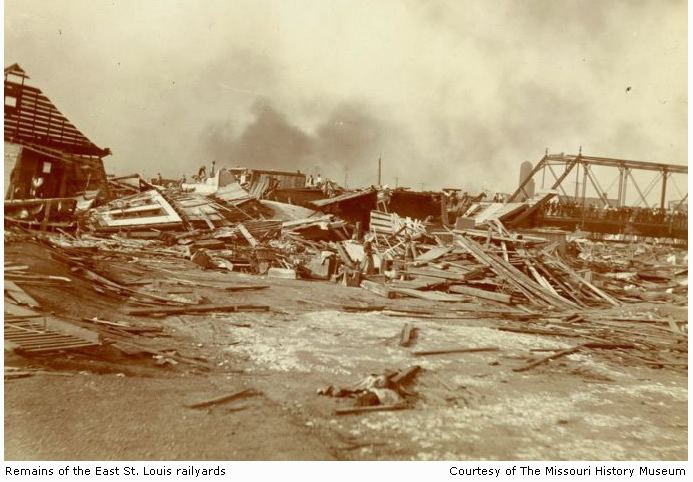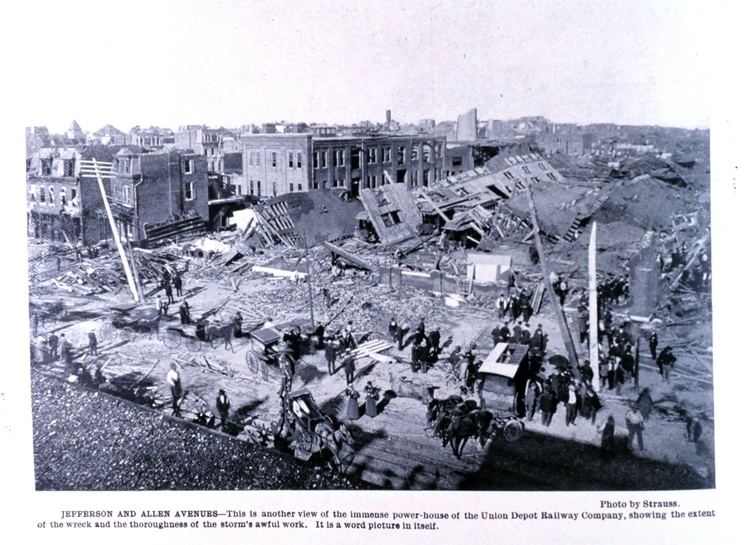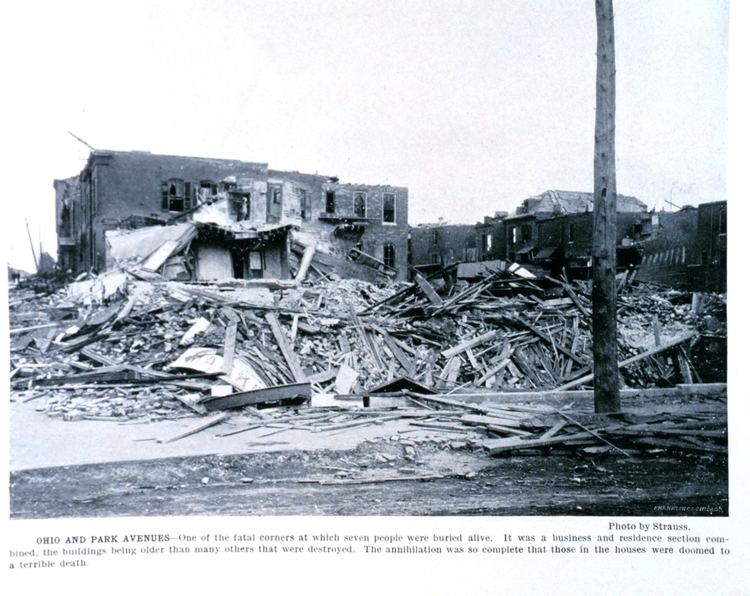Type Tornado outbreak Tornadoes confirmed Unknown Duration of tornado outbreak Unknown | Duration May 27–28, 1896 Max rating | |
 | ||
Damage $4.3 bil. (2015 US$) [$3.9 billion (2009 US$)] | ||
The 1896 St. Louis – East St. Louis tornado was a historic tornado that occurred on Wednesday, May 27, 1896, as part of a major tornado outbreak across the Central United States that day, continuing across the Eastern United States on the 28th. One of the deadliest and most destructive tornadoes in U.S. history, this large and violent tornado was the most notable of an outbreak which produced other large, long-track, violent, killer tornadoes. It caused over $10,000,000 in damage in 1896 ($4.35 billion in today's dollars). 255 people died, and over a thousand were injured. More than 5000 people were homeless and lost all of their possessions.
Contents
- May 27 outbreak
- St Louis East St Louis tornado
- St Louis tornado history
- Other May 1896 tornadoes
- 1896 tornado season
- References

May 27 outbreak

While a cyclone had been predicted for the later days in May, many disregarded the warning or felt that St. Louis city would not be affected. The day started quietly, with people going about their daily business. The weather in the morning did not indicate any severe threat of a tornado. The local weather bureau predicted thunderstorms, but nothing more serious. Around noon, the clouds began to appear more ominous and the barometric pressure dropped, alarming those who knew that was an indication of a tornado.

Into the afternoon, the skies started to darken, but the Weather Bureau Observatory was not overly concerned. Many residents, however, fled to their homes, anticipating severe weather. At 4:30, the temperature fell rapidly and black and greenish clouds approached the city. Near 5:00 pm, it was as dark as it would otherwise be 3 hours later in the day. As the thunderstorm approached St. Louis, the western portion of the city was particularly affected. The winds were initially around 37 miles per hour, but they quickly increased to almost 80 miles per hour.

The first significant tornado of the day formed near Bellflower, Missouri and killed a woman. Three students died and sixteen were injured when the Dye School in Audrain County, Missouri was hit at around 6:15 pm. The same tornado killed one student and injured 19 others at the Bean Creek school a few minutes later. At 6:30, two supercell thunderstorms produced two tornadoes. One decimated farms in New Minden, Hoyleton, Richview, and Irvington, Illinois.
Twenty-seven more people died in the other Illinois tornadoes of this outbreak.
St. Louis – East St. Louis tornado

The tornado spawned from the other supercell became the third deadliest and the most costly tornado in United States history. It touched down in St. Louis, Missouri, then one of the largest and most influential cities in the country. At least 137 people died as the tornado traversed the core of the city leaving a 1 mile (1.6 km) wide continuous swath of destroyed homes, schools, saloons, factories, mills, churches, parks, and railroad yards. A few of the destroyed homes were swept away. Numerous trees were downed at the 36-acre (0.15 km2) Lafayette Park, and a barometer recorded a drop to 26.74 inHg (906 hPa) at this location. Uncounted others may have died on boats on the Mississippi River, which could have swept their bodies downriver.

Where the tornado crossed the Mississippi and struck the Eads Bridge, a 2 in × 10 in (51 mm × 254 mm) wooden plank was found driven through a 5⁄16 in (7.9 mm) wrought iron plate. The tornado continued into East St. Louis, Illinois, where it was smaller, but more intense. Homes and buildings along the river were completely swept away and a quarter of the buildings there were damaged or destroyed. An additional 118 people were killed, and 35 of those deaths alone occurred at the Vandalia railroad freight yards. The confirmed death toll is 255, with some estimates above 400. More than 1,000 were injured. The tornado was later rated F4 on the Fujita scale. Enough damage was done to the city that there was some question that St. Louis might not be able to host the 1896 Republican National Convention in June.
Following the cyclone's destruction, members of Light Battery "A" and the First Regiment were placed on volunteer duty. Within an hour of the tornado striking, 32 members were on duty with ambulances and hospital corps to assist in rescue operations and to help victims. The mayor asked that both commands remain on patrol duty on May 30. Members of the bicycle corps of Company "G" First Regiment assisted when railway service was inaccessible. Telephone and telegraph wires were destroyed and streets were impassable. Officers were summoned to duty by bicycle couriers, as this way the only means of communication after the city's destruction.
St. Louis tornado history
It is somewhat infrequent for the core of a large city to be hit directly by a tornado (due to their relatively small area and the relative lack of large cities in the highest tornado threat region)—especially a large intense tornado—yet several other tornadoes have tracked through the City of St. Louis and several of these tornadoes were also very deadly and destructive. Among these events are: 1871 (9 killed), 1890 (4 killed), 1904 (3 killed, 100 injured), 1927 (79 killed, 550 injured, once the 2nd costliest in US history), and 1959 (21 killed, 345 injured). This makes St. Louis the worst tornado afflicted urban area in the U.S. Additionally, the Greater St. Louis area is the scene of even more historically destructive and deadly tornadoes. Oklahoma City is the metropolitan area with the most frequent significant tornadoes.
Other May 1896 tornadoes
In what was apparently an intense tornado outbreak sequence, other major tornado outbreaks occurred on May 15, May 17, and May 24–25, with other smaller outbreaks during the month as well. The middle to end of May was extremely active but sparse records preclude knowing much detail. Tom Grazulis has stated that the week of May 24–28 was "perhaps the most violent single week of tornado activity in US history".
1896 tornado season
The 1896 tornado season has the distinction of being one of the deadliest in United States history. There were at least 40 killer tornadoes spanning from April 11 to November 26; including this one, the only one to kill more than 100 people in two separate cities.
